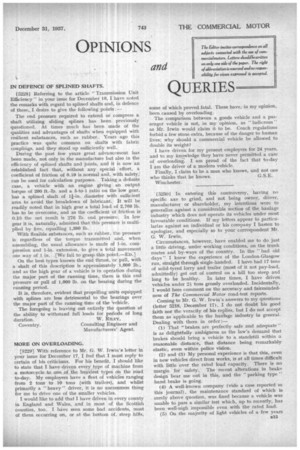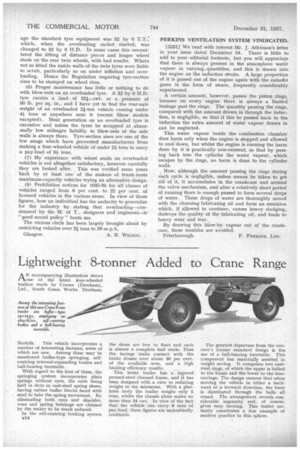OPINIONS
Page 25

Page 26

If you've noticed an error in this article please click here to report it so we can fix it.
and
QUERIES
IN DEFENCE OF SPLINED SHAFTS.
[5228] Referring to the article "Transmission Unit Efficiency" in your issue for December 10, I have noted the remarks with regard to splined shafts and, in defence of these, I desire to give the following points:— The end pressure required to extend or compress a shaft utilizing sliding splines has been previously questioned. At times much has been made of the qualities and advantages of shafts when equipped with resilient substances, such as rubber. Years ago this practice was quite common on shafts with fabric couplings, and they stood up sufficiently well.
During the past few years great advancement has been made, not only in the manufacture but also in the efficiency of splined shafts and joints, and it is now an established fact that, without any special effort, a coefficient of friction of 0.10 is normal and, with safety, can be used for calculation purposes. Taking a definite case, a vehicle with an engine giving an output torque of 200 ft.-lb, and a 5-to-1 ratio on the low gear, has a splined shaft of 11-in. diameter with sufficient area to avoid the breakdown of lubricant. It will be readily noted that in high gear a total load of 2,760 lb. has to be overcome, and as the coefficient of friction is 0.10 the net result is 276 lb. end pressure. In low gear it is, naturally, admitted that this pressure is multiplied by five, equalling 1,380 lb.
With flexible substances, such as rubber, the pressure is regardless of the torque transmitted and, when assembling, the usual allowance is made of 1-in. compression and 1-in, extension, to give a total movement one way of 1 in. [We fail to grasp this point.—En.]
On the best types known the end thrust, or pull, with a shaft of this description is approximately 1,000 lb., and as the high gear of a vehicle is in operation during the major part of the running time, there is this end pressure or pull of 1,000 lb. on the bearing during the running period.
It is, therefore, evident that propelling units equipped with splines are less detrimental to the bearings over the major part of the running time of the vehicle.
The foregoing is leaving out entirely the question of the ability to withstand full loads for periods of long
duration. W. RILEY,
Coventry. Consulting Engineer and Manufacturers' Agent.
MORE ON OVERLOADING.
[5229] With reference to Mr. G. W. Irwin's letter in your issue for December 17, I feel that I must reply to certain of his criticisms. For his benefit, I should like to state that I have driven every type of machine from a motorcycle to one of the heaViest types on the road to-day. My employers have a fleet of vehicles ranging from 2 tons to 10 tons (with trailers), and whilst primarily a " heavy" driver, it is no uncommon thing for me to drive one of the smaller vehicles.
I would like to add that I have driven in every county in England and Wales, and in most of the Scottish counties, too. I have seen some bad accidents, most of them occurring on, or at the bottom of, steep hilts, some of which proved fatal. These have, in my opinion, been caused by overloading.
The comparison between a goods vehicle and a passenger vehicle is not, in my opinion, as " ludicrous " as Mr. Irwin would claim it to be. Coach regulations forbid a few stone extra, because of the danger to human lives; why should a commercial vehicle be allowed to double its weight?
I have driven for my present employers for 24 years, and to my knowledge they have never permitted a case of overloading. I am proud of the fact that to-day
I am the driver of a modern vehicle.
Finally, I claim to be a man who knows, and not one who thinks that he knows. G. S.E. Winchester.
[52301 In entering this controversy, having no specific axe to grind, and not being owner, driver, manufacturer or shareholder, my intentions were to generalize against a considerable section of the haulage industry which does not operate its vehicles under most favourable conditions. If my letters appear to particularize against an individual or his company I hasten to apologize, and especially so to your correspondent Mr. G. W. Irwin.
Circumstances, however, have enabled me to do just a little driving, under working conditions, on the trunk routes and by-ways of the country. In the "bad old days" I knew the experience of the London-Glasgow run, straight through single-handed. I have had 17 tons of solid-tyred lorry and trailer (most of it not pay-load, admittedly) get out of control on a hill too steep and long to be healthy. In later times, I have driven vehicles under Dr tons grossly overloaded. Incidentally, I would here comment on the accuracy and fairmindedness of The Commercial Motor road-test reports.
Coming to Mr. G. W. Irwin's answers to my questions (letter 5218, December 17), I do not doubt his good faith nor the veracity of his replies, but I do not accept them as applicable to the haulage industry in general. Dealing with them in order :
(1) That "brakes are perfectly safe and adequate" is as delightfully ambiguous as the law's demand that brakes should bring a vehicle to a standstill within a reasonable distance, that distance being remarkably elastic, even within police vision.
(2) and (3) My personal experience is that this, even in new vehicles direct from works, is at all times difficult with little over the rated load capacity. There is no margin for safety. The recent alterations in brake design bear me out in this, and the "parking type" hand brake is going.
(4) A well-known company (vide a case reported in this journal), the maintenance standard of which is surely above question, was fined because a vehicle was unable to pass a similar test which, up to recently, has been well-nigh impossible even with the rated load.
(5) On the majority of light vehicles of a few years B13
ago the standard tyre equipment was 32 by 6 T.T. which, when the overloading racket started, was changed to 32 by 6 H.D. In some cases this necessitated the fitting of distance pieces and longer wheel studs on the rear twin wheels, with bad results. Where not so fitted the inside walls of the twin tyres were liable to scrub, particularly so on under inflation and overloading. Hence the Regulation requiring tyre-section sizes to be stamped on wheel rims.
(6) Proper maintenance has little or nothing to do with blow-outs on an overloaded tyre. A 32 by 6 H.D. tyre carries a load of 221... cwt. at a pressure of 90 lb. per sq. in., and I have yet to find the rear-axle weight of an overloaded 21-tort vehicle coming under 4i tons or anywhere near it (recent Show models excepted). Heat generation on an overloaded tyre is excessive and unless the tyres be scrapped at abnormally low mileages liability to blow-outs of the side walls is always there. Tyre-section sizes are one of the few snags which have prevented manufacturers from making a four-wheeled vehicle of under 2i tons to carry a pay-load of 9i tons.
(7) My experience with wheel studs on overloaded vehicles is not altogether satisfactory, however carefully they are looked after. This was verified some years back by at least one of the makers of trunk-route maximum-capacity vehicles trying an alternative design.
(81 Prohibition notices for 1935-30 for all classes of vehicles ranged from 6 per cent. to 25 per cent, of licensed vehicles in the various areas. In view of those figures, how an individual has the audacity to generalize for the industry by stating that overloading—condemned by the M. of T., designers and engineers—is "good sound policy" beats me.
The vicious circle has been largely brought about by restricting vehicles over 2/ tons to 20 m.p.h.
Glasgow. A. R. WILSON. , PERKINS VENTILATION SYSTEM VINDICATED.
[5231] We read with interest Mr. J. Atkinson's letter in your issue dated December 24. There is little to add to your editorial footnote, but, you will appreciate that there is always present in the atmosphere water vapour in varying, quantities, and this is drawn into the engine on the induction stroke. A large proportion of it is passed out of the engine again with the exhaist gases in the form of steam, frequently considerably superheated.
A certain amount, however, passes the piston rings, because on every engine there is always a limited leakage past the rings. The quantity passing the rings, compared with the amount drawn in through the induction, is negligible, so that if this be passed back to the induction the extra amount of water vapour drawn in can be neglected.
This water vapour inside the combustion chamber does harm only when the engine is stopped and allowed to cool down, but whilst the engine is running the harm done by it is practically non-existent, so that by passing back into the cylinder the water vapour, which escapes by the rings, no harm is done to the cylinder walls.
Now, although the amount passing the rings during each cycle is negligible, unless means be taken to get rid of it, it accumulates in the crankcase and around the valve mechanism, and after a relatively short period of running there is enough passed to form several drops of water. These drops of water are thoroughly mixed with the churning lubricating oil and form an emulsion which, if allowed to continue, causes heavy sludging, destroys the quality of the lubricating oil, and leads to heavy wear and tear.
By drawing this blow-by vapour out of the crankcase, these troubles are avoided.
Peterborough. F. PERKINS, LTD.
































